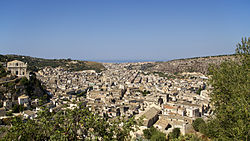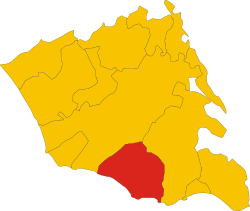Scicli
You can helpexpand this article with text translated fromthe corresponding articlein Italian.(January 2022)Click [show] for important translation instructions.
|
Scicli | |
|---|---|
| Comune di Scicli | |
 | |
 Scicli within the Province of Ragusa | |
| Coordinates:36°47′17″N14°41′52″E/ 36.78806°N 14.69778°E | |
| Country | Italy |
| Region | Sicily |
| Province | Ragusa(RG) |
| Frazioni | Arizza, Bruca,Cava d'Aliga,Donnalucata,Playa Grande,Sampieri |
| Government | |
| • Mayor | Mario Marino |
| Area | |
| • Total | 138.72 km2(53.56 sq mi) |
| Elevation | 108 m (354 ft) |
| Population (31 December 2017)[2] | |
| • Total | 27,051 |
| • Density | 200/km2(510/sq mi) |
| Demonym | Sciclitani |
| Time zone | UTC+1(CET) |
| • Summer (DST) | UTC+2(CEST) |
| Postal code | 97018 |
| Dialing code | 0932 |
| Patron saint | Madonna of the Milices |
| Saint day | Last Saturday of May |
| Website | Official website |
| Part of | Late Baroque Towns of theVal di Noto(South-EasternSicily) |
| Criteria | Cultural: (i)(ii)(iv)(v) |
| Reference | 1024rev-008 |
| Inscription | 2002 (26thSession) |
| Area | 0.82 ha (88,000 sq ft) |
| Buffer zone | 5.18 ha (558,000 sq ft) |
Scicliis a town and municipality in theProvince of Ragusain the south east ofSicily,southernItaly.It is 25 kilometres (16 mi) fromRagusa,and 188 kilometres (117 mi) fromPalermo,and has a population (2017) of 27,051.[2]Alongside seven other cities in theVal di Noto,it has been listed as one ofUNESCO'sWorld Heritage Sites.
The municipality borders withModicaandRagusa.[3]

History
[edit]Settlements of the area of Scicli dates back to the Copper and Early Bronze Ages (3rd millennium BC to the 15th century BC).
Scicli was founded by theSicels(whence probably the name) around 300 BC.
In 864 AD, Scicli was conquered by theArabs,as part of theMuslim conquest of Sicily.[4]Under their rule it flourished as an agricultural and trade center. According to geographerMuhammad al-Idrisi,"shipping reached Scicli in Sicily from Calabria, Africa, Malta and many other places."[5]
In 1091, it was conquered from the Arabs by theNormans,underRoger I of Hauteville,after a fierce battle.[6]Scicli was one of the garrison which rebelled against theAngevinedomination in theSicilian Vespers(April 5, 1282). The rulingAragonese-Spanishkings formed theCounty of Modicaand initially placed it under the rule of the Chiaramonte family. From there it became a feud of the Cabrera family until nearly the mid-18th century. A number of counts from the House of Alba nominally held possession until the county theKingdom of Italyin the mid 19th century.
Following a catastrophicearthquake in 1693,much of the town was rebuilt in theSicilian baroquestyle, which today gives the town the elegant appearance which draws many tourists to visit it.
Main sights
[edit]This sectionis written like atravel guide.(January 2022) |
- San Matteo:this was the local "mother churchof the town until 1874. It is located on the eponymous hill in the old city, where there is also the ruin of an Arab/Norman castle.[7]
- Santa Maria la Nova:church with a largeNeoclassicfaçade. The interior houses a cypress-wood statue ofMadonna della Pietà,probably of Byzantine origin.
- San Bartolomeobaroque church
- Sant'Ignazio(Mother Church of St Ignatius of Loyola), houses the highly venerated image ofMadonna dei Milìci(seeCulturesection).
- San Michele Arcangelo
- Palazzo Fava,one of the first and largest Baroque palaces in the town. Notable are the late-Baroque decorations of the portal and the balconies, especially the one on the Via San Bartolomeo.
- The Town Hall, thePalazzo Spadaroand thePalazzo Beneventano,all boast Baroque decorations.
Culture
[edit]Scicli is frequently used as afilm set,most recently forMarco Bellocchio'sIl regista dei matrimoniand is popular in Italy as the location of the police station (Commissariato) ofIl Commissario Montalbano,the popular television series broadcast byRAI.
The town is also notable for its religiousprocessionswhich includes "Presepe" (nativity scenes) enacted in thecavessurrounding the city atChristmastime. These caves, known as theChiarafura caves,were dug out in thetuffcliffs, and some were inhabited by the local poor as recently as 1958.
AtEaster,the town celebrates with the "Uomo Vivo" parade which involves a long religiousprocessionthrough the city. A decorated horse parade takes place in March, from Scicli to the neighbouring town ofDonnalucata.The most spectacular religious festival, theA Maronna i Milicioccurs in May, commemorating the appearance ofthe Madonnaon a white horse holding aloft a sword, described as "probably...the only armed Holy Virgin in the world."[8]This encouraged the Christian Normans to defeat theSaracensin 1091. However, the story itself is believed to have been first promoted no earlier than the 15th century.[9]
Economy
[edit]
The economy of Scicli is mostly agricultural, and the area is renowned for its manygreenhousesproducing theprimizie( "early fruits" ) that are exported all over Italy.
Sport
[edit]The local association football club is theU.P.D. Scicli;and thefutsalclub is thePro Scicli,that also played inSerie A.The town plays host to an annualroad runningrace,Memorial Peppe Greco,which traces its route through the city centre.
Transport
[edit]Scicli has a railway station on theCanicattì-Gela-Ragusa-Syracuseline. Another station serves thefrazioneofSampieri.
The town will be served by the planned extension, to Ragusa and Gela, of theA18 motorway.
People
[edit]- Giuseppe Drago(1955–2016), physician and politician,President of Sicilyin 1998
- Severino Santiapichi(1926–2016), magistrate and writer
References
[edit]- ^"Superficie di Comuni Province e Regioni italiane al 9 ottobre 2011".Italian National Institute of Statistics.Retrieved16 March2019.
- ^ab(in Italian)Source:Istat2011
- ^39161Scicli onOpenStreetMap
- ^Alexander Mikaberidze(22 Jul 2011).Conflict and Conquest in the Islamic World: A Historical Encyclopedia [2 volumes].ABC-CLIO. p. 831.ISBN9781598843378.
- ^Lorenza De Maria; Rita Turchetti (2004).Rotte e porti del Mediterraneo dopo la caduta dell'Impero romano d'Occidente: continuità e innovazioni tecnologiche e funzionali: IV seminario: Genova, 18-19 giugno 2004.Rubbettino Editore. p. 125.ISBN9788849811179.
- ^Authentic Sicily(illustrated ed.). Touring Editore. 2005. p. 73.ISBN9788836534036.
- ^Peter Amann (1 Jan 2001).Sicily(illustrated ed.). Hunter Publishing, Inc. p. 42.ISBN9781856911580.
- ^Marcella Croce (20 Oct 2014).The Chivalric Folk Tradition in Sicily: A History of Storytelling, Puppetry, Painted Carts and Other Arts.McFarland. p. 48.ISBN9780786494156.
- ^Amy G. Remensnyder (2014).La Conquistadora: The Virgin Mary at War and Peace in the Old and New Worlds(illustrated ed.). Oxford University Press. p. 395.ISBN9780199893003.
External links
[edit]- (in Italian)Scicli official website
- (in English)Scili Information
- Cartoon map of Scicli




